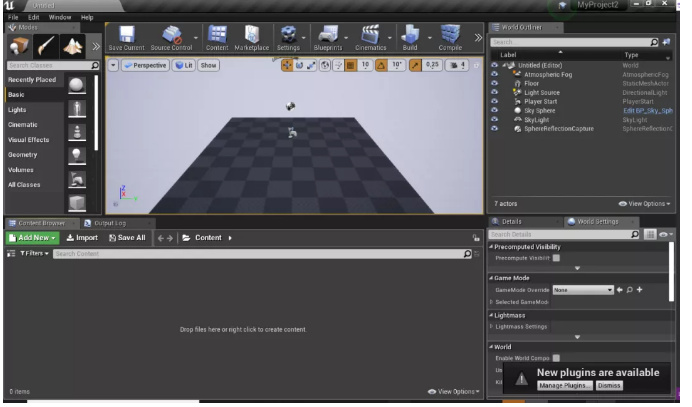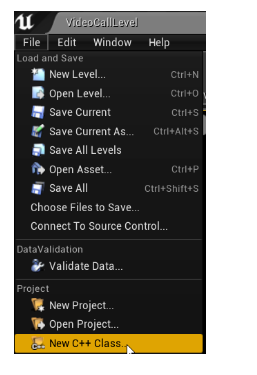教你用 C++ 在 Unreal 中为游戏增加实时音视频互动(上)
我们已经上线了 Agora Unreal SDK,提供了支持 Blueprint 和 C++ 的两个版本 SDK。我们分享了如何基于 Blueprint 在游戏中创建实时音视频功能。在本文中,我们来分享如何基于声网 Agora Unreal SDK C++版本,在游戏中实现实时音视频功能。
本篇教程较长,建议在 Web 浏览器端浏览,体验更好。
准备工作
需要的开发环境和需要准备的与 Blueprint 一样:
- Unreal 4.34 以上版本
- Visual Studio 或 Xcode(版本根据 Unreal 配置要求而定)
- 运行 Windows 7 以上系统的 PC 或 一台 Mac
- Agora 注册账号一枚(免费注册,见官网 Agora.io)
- 如果你的企业网络存在防火墙,请在声网文档中心搜索「应用企业防火墙限制」,进行配置。
新建项目
如果你已经有 Unreal 项目了,可以跳过这一步。在 Unreal 中创建一个 C++类型的项目。

确保在 [your_project]/Source/[project_name]/[project_name].Build.cs文件的 PrivateDependencyModuleNames一行,去掉注释。Unreal 默认是将它注释掉的,这会导致在编译的时候报错。
1. // Uncomment if you are using Slate UI
2. PrivateDependencyModuleNames.AddRange(new string[] { "UMG", "Slate", "SlateCore" });
接下来我们在项目中集成 Agora SDK
1.将 SDK 复制到这个路径下 [your_project]/Plugins
2.把插件依赖添加到[your_project]/Source/[project_name]/[project_name].Build.cs文件的私有依赖(Private Dependencies)部分 PrivateDependencyModuleNames.AddRange(new string[] { “AgoraPlugin”, “AgoraBlueprintable” });
3.重启 Unreal
4.点击 Edit->Plugin,在分类中找到 Project->Other,确定插件已经生效

创建新的 Level
接下来我们将创建一个新的 Level,在那里建立我们的游戏环境。有几种不同的方法可以创建一个新的 Level,我们将使用文件菜单的方法,其中列出了关卡选择选项。
在虚幻编辑器里面,点击文件菜单选项,然后选择新建 Level…

然后会打开一个新的对话框。

选择Empty Level ,然后指定一个存储的路径。
创建核心类
在这里我们要创建两个类:VideoFrameObserver 和VideoCall C++ Class。他们会负责与 Agora SDK 进行通信。
首先是 VideoFrameObserver。VideoFrameObserver 执行的是 agora::media::IVideoFrameObserver。这个方法在 VideoFrameObserver 类中负责管理视频帧的回调。它是用 registerVideoFrameObserver 在 agora::media::IMediaEngine 中注册的。
在 Unreal 编辑器中,选择 File->Add New C++ Class。

父类谁定为 None,然后点击下一步。

为 VideoFrameObserver明明,然后选择 Create Class。

创建 VideoFrameObserver 类接口。
打开 VideoFrameObserver.h 文件然后添加如下代码:
1 //VideoFrameObserver.h
2
3 #include "CoreMinimal.h"
4
5 #include <functional>
6
7 #include "AgoraMediaEngine.h"
8
9 class AGORAVIDEOCALL_API VideoFrameObserver : public agora::media::IVideoFrameObserver
10 {
11 public:
12 virtual ~VideoFrameObserver() = default;
13 public:
14 bool onCaptureVideoFrame(VideoFrame& videoFrame) override;
15
16 bool onRenderVideoFrame(unsigned int uid, VideoFrame& videoFrame) override;
17
18 void setOnCaptureVideoFrameCallback(
19 std::function<void(std::uint8_t*, std::uint32_t, std::uint32_t, std::uint32_t)> callback);
20
21 void setOnRenderVideoFrameCallback(
22 std::function<void(std::uint8_t*, std::uint32_t, std::uint32_t, std::uint32_t)> callback);
23
24 virtual VIDEO_FRAME_TYPE getVideoFormatPreference() override { return FRAME_TYPE_RGBA; }
25
26 private:
27
28 std::function<void(std::uint8_t*, std::uint32_t, std::uint32_t, std::uint32_t)> OnCaptureVideoFrame;
29 std::function<void(std::uint8_t*, std::uint32_t, std::uint32_t, std::uint32_t)> OnRenderVideoFrame;
30 };
AGORAVIDEOCALL_API 是项目依赖的定义,而不是由Unreal 生成的你自己的定义。
重写onCaptureVideoFrame/onRenderVideoFrame方法
onCaptureVideoFrame 会获取到摄像头捕获的画面,转换为 ARGB 格式并触发 OnCaptureVideoFrame 回调。
onRenderVideoFrame 讲收到的特定用户画面转换为 ARGB 格式,然后触发 onRenderVideoFrame 回调。
//VideoFrameObserver.cpp
bool VideoFrameObserver::onCaptureVideoFrame(VideoFrame& Frame)
{
const auto BufferSize = Frame.yStride*Frame.height;
if (OnCaptureVideoFrame)
{
OnCaptureVideoFrame( static_cast< uint8_t* >( Frame.yBuffer ), Frame.width, Frame.height, BufferSize );
}
return true;
}
bool VideoFrameObserver::onRenderVideoFrame(unsigned int uid, VideoFrame& Frame)
{
const auto BufferSize = Frame.yStride*Frame.height;
if (OnRenderVideoFrame)
{
OnRenderVideoFrame( static_cast<uint8_t*>(Frame.yBuffer), Frame.width, Frame.height, BufferSize );
}
return true;
}
增加setOnCaptureVideoFrameCallback/setOnRenderVideoFrameCallback方法。
设定回调,用来获取摄像头获取到的本地画面和远端的画面。
//VideoFrameObserver.cpp
void VideoFrameObserver::setOnCaptureVideoFrameCallback(
std::function<void(std::uint8_t*, std::uint32_t, std::uint32_t, std::uint32_t)> Callback)
{
OnCaptureVideoFrame = Callback;
}
void VideoFrameObserver::setOnRenderVideoFrameCallback(
std::function<void(std::uint8_t*, std::uint32_t, std::uint32_t, std::uint32_t)> Callback)
{
OnRenderVideoFrame = Callback;
}
创建视频通话C++类
VideoCall 类管理与 Agora SDK 的通信。需要创建多个方法和接口。
创建类接口
回到 Unreal 编辑器,再创建一个新的 C++类,命名为 VideoCall.h。然后进入VideoCall.h文件,添加一下接口:
//VideoCall.h
#pragma once
#include "CoreMinimal.h"
#include <functional>
#include <vector>
#include "AgoraRtcEngine.h"
#include "AgoraMediaEngine.h"
class VideoFrameObserver;
class AGORAVIDEOCALL_API VideoCall
{
public:
VideoCall();
~VideoCall();
FString GetVersion() const;
void RegisterOnLocalFrameCallback(
std::function<void(std::uint8_t*, std::uint32_t, std::uint32_t, std::uint32_t)> OnLocalFrameCallback);
void RegisterOnRemoteFrameCallback(
std::function<void(std::uint8_t*, std::uint32_t, std::uint32_t, std::uint32_t)> OnRemoteFrameCallback);
void StartCall(
const FString& ChannelName,
const FString& EncryptionKey,
const FString& EncryptionType);
void StopCall();
bool MuteLocalAudio(bool bMuted = true);
bool IsLocalAudioMuted();
bool MuteLocalVideo(bool bMuted = true);
bool IsLocalVideoMuted();
bool EnableVideo(bool bEnable = true);
private:
void InitAgora();
private:
TSharedPtr<agora::rtc::ue4::AgoraRtcEngine> RtcEnginePtr;
TSharedPtr<agora::media::ue4::AgoraMediaEngine> MediaEnginePtr;
TUniquePtr<VideoFrameObserver> VideoFrameObserverPtr;
//callback
//data, w, h, size
std::function<void(std::uint8_t*, std::uint32_t, std::uint32_t, std::uint32_t)> OnLocalFrameCallback;
std::function<void(std::uint8_t*, std::uint32_t, std::uint32_t, std::uint32_t)> OnRemoteFrameCallback;
bool bLocalAudioMuted = false;
bool bLocalVideoMuted = false;
};
创建初始化方法
进入 VideoCall.cpp 文件,添加以下代码:
//VideoCall.cpp
#include "AgoraVideoDeviceManager.h"
#include "AgoraAudioDeviceManager.h"
#include "MediaShaders.h"
#include "VideoFrameObserver.h"
用agora::rtc::ue4::AgoraRtcEngine::createAgoraRtcEngine()创建引擎,初始化 RtcEnginePtr 变量。创建一个RtcEngineContext对象,然后在ctx.eventHandler 和ctx.appId中设定 event handler 和 App ID 。初始化引擎,并创建AgoraMediaEngine对象,初始化 MediaEnginePtr。
//VideoCall.cpp
VideoCall::VideoCall()
{
InitAgora();
}
VideoCall::~VideoCall()
{
StopCall();
}
void VideoCall::InitAgora()
{
RtcEnginePtr = TSharedPtr<agora::rtc::ue4::AgoraRtcEngine>(agora::rtc::ue4::AgoraRtcEngine::createAgoraRtcEngine());
static agora::rtc::RtcEngineContext ctx;
ctx.appId = "aab8b8f5a8cd4469a63042fcfafe7063";
ctx.eventHandler = new agora::rtc::IRtcEngineEventHandler();
int ret = RtcEnginePtr->initialize(ctx);
if (ret < 0)
{
UE_LOG(LogTemp, Warning, TEXT("RtcEngine initialize ret: %d"), ret);
}
MediaEnginePtr = TSharedPtr<agora::media::ue4::AgoraMediaEngine>(agora::media::ue4::AgoraMediaEngine::Create(RtcEnginePtr.Get()));
}
FString VideoCall::GetVersion() const
{
if (!RtcEnginePtr)
{
return "";
}
int build = 0;
const char* version = RtcEnginePtr->getVersion(&build);
return FString(ANSI_TO_TCHAR(version));
}
创建回调方法
接下来创建回调方法,返回本地和远端的视频帧
//VideoCall.cpp
void VideoCall::RegisterOnLocalFrameCallback(
std::function<void(std::uint8_t*, std::uint32_t, std::uint32_t, std::uint32_t)> OnFrameCallback)
{
OnLocalFrameCallback = std::move(OnFrameCallback);
}
void VideoCall::RegisterOnRemoteFrameCallback(
std::function<void(std::uint8_t*, std::uint32_t, std::uint32_t, std::uint32_t)> OnFrameCallback)
{
OnRemoteFrameCallback = std::move(OnFrameCallback);
}
创建呼叫方法
我们需要利用这个方法来实现“加入频道”和“离开频道”。
增加 StartCall
首先创建 VideoFrameObserver 对象,然后根据你的场景来设置以下回调。
- OnLocalFrameCallback:用于 SDK 获取本地摄像头采集到的视频帧。
- OnRemoteFrameCallback:用于 SDK 获取远端摄像头采集到的视频帧。
在 InitAgora 的 MediaEngine 对象中通过 registerVideoFrameObserver 方法注册 VideoFrameObserver。为了保证 EncryptionType 和 EncryptionKey 不为空,需要先设置 EncryptionMode 和 EncryptionSecret。然后按照你的需要来设置频道参数,并调用 joinChannel。
//VideoCall.cpp
void VideoCall::StartCall(
const FString& ChannelName,
const FString& EncryptionKey,
const FString& EncryptionType)
{
if (!RtcEnginePtr)
{
return;
}
if (MediaEnginePtr)
{
if (!VideoFrameObserverPtr)
{
VideoFrameObserverPtr = MakeUnique<VideoFrameObserver>();
std::function<void(std::uint8_t*, std::uint32_t, std::uint32_t, std::uint32_t)> OnCaptureVideoFrameCallback
= [this](std::uint8_t* buffer, std::uint32_t width, std::uint32_t height, std::uint32_t size)
{
if (OnLocalFrameCallback)
{
OnLocalFrameCallback(buffer, width, height, size);
}
else { UE_LOG(LogTemp, Warning, TEXT("VideoCall OnLocalFrameCallback isn't set")); }
};
VideoFrameObserverPtr->setOnCaptureVideoFrameCallback(std::move(OnCaptureVideoFrameCallback));
std::function<void(std::uint8_t*, std::uint32_t, std::uint32_t, std::uint32_t)> OnRenderVideoFrameCallback
= [this](std::uint8_t* buffer, std::uint32_t width, std::uint32_t height, std::uint32_t size)
{
if (OnRemoteFrameCallback)
{
OnRemoteFrameCallback(buffer, width, height, size);
}
else { UE_LOG(LogTemp, Warning, TEXT("VideoCall OnRemoteFrameCallback isn't set")); }
};
VideoFrameObserverPtr->setOnRenderVideoFrameCallback(std::move(OnRenderVideoFrameCallback));
}
MediaEnginePtr->registerVideoFrameObserver(VideoFrameObserverPtr.Get());
}
int nRet = RtcEnginePtr->enableVideo();
if (nRet < 0)
{
UE_LOG(LogTemp, Warning, TEXT("enableVideo : %d"), nRet)
}
if (!EncryptionType.IsEmpty() && !EncryptionKey.IsEmpty())
{
if (EncryptionType == "aes-256")
{
RtcEnginePtr->setEncryptionMode("aes-256-xts");
}
else
{
RtcEnginePtr->setEncryptionMode("aes-128-xts");
}
nRet = RtcEnginePtr->setEncryptionSecret(TCHAR_TO_ANSI(*EncryptionKey));
if (nRet < 0)
{
UE_LOG(LogTemp, Warning, TEXT("setEncryptionSecret : %d"), nRet)
}
}
nRet = RtcEnginePtr->setChannelProfile(agora::rtc::CHANNEL_PROFILE_COMMUNICATION);
if (nRet < 0)
{
UE_LOG(LogTemp, Warning, TEXT("setChannelProfile : %d"), nRet)
}
//"demoChannel1";
std::uint32_t nUID = 0;
nRet = RtcEnginePtr->joinChannel(NULL, TCHAR_TO_ANSI(*ChannelName), NULL, nUID);
if (nRet < 0)
{
UE_LOG(LogTemp, Warning, TEXT("joinChannel ret: %d"), nRet);
}
}
增加 StopCall 功能
根据你的场景需要,通过调用 leaveChannel 方法来结束通话,比如当要结束通话的时候,当你需要关闭应用的时候,或是当你的应用运行于后台的时候。调用 nullptr 作为实参的 registerVideoFrameObserver,用来取消 VideoFrameObserver的注册。
//VideoCall.cpp
void VideoCall::StopCall()
{
if (!RtcEnginePtr)
{
return;
}
auto ConnectionState = RtcEnginePtr->getConnectionState();
if (agora::rtc::CONNECTION_STATE_DISCONNECTED != ConnectionState)
{
int nRet = RtcEnginePtr->leaveChannel();
if (nRet < 0)
{
UE_LOG(LogTemp, Warning, TEXT("leaveChannel ret: %d"), nRet);
}
if (MediaEnginePtr)
{
MediaEnginePtr->registerVideoFrameObserver(nullptr);
}
}
}
创建 Video 方法
这些方法是用来管理视频的。
加 EnableVideo() 方法
EnableVideo() 会启用本示例中的视频。初始化 nRet,值为 0。如果 bEnable 为 true,则通过 RtcEnginePtr->enableVideo() 启用视频。否则,通过 RtcEnginePtr->disableVideo() 关闭视频。
//VideoCall.cpp
bool VideoCall::EnableVideo(bool bEnable)
{
if (!RtcEnginePtr)
{
return false;
}
int nRet = 0;
if (bEnable)
nRet = RtcEnginePtr->enableVideo();
else
nRet = RtcEnginePtr->disableVideo();
return nRet == 0 ? true : false;
}
增加 MuteLocalVideo() 方法
MuteLocalVideo() 方法负责开启或关闭本地视频。在其余方法完成运行之前,需要保证 RtcEnginePtr 不为 nullptr。如果可以成功mute 或 unmute 本地视频,那么把 bLocalVideoMuted 设置为 bMuted。
//VideoCall.cpp
bool VideoCall::MuteLocalVideo(bool bMuted)
{
if (!RtcEnginePtr)
{
return false;
}
int ret = RtcEnginePtr->muteLocalVideoStream(bMuted);
if (ret == 0)
bLocalVideoMuted = bMuted;
return ret == 0 ? true : false;
}
增加 IsLocalVideoMuted() 方法
IsLocalVideoMuted() 方法的作用是,当本地视频开启或关闭的时候,返回 bLocalVideoMuted。
//VideoCall.cpp
bool VideoCall::IsLocalVideoMuted()
{
return bLocalVideoMuted;
}
创建音频相关的方法
这些方法是用来管理音频的。
添加 MuteLocalAudio() 方法
MuteLocalAudio()用于 mute 或 unmute 本地音频:
//VideoCall.cpp
bool VideoCall::MuteLocalAudio(bool bMuted)
{
if (!RtcEnginePtr)
{
return false;
}
int ret = RtcEnginePtr->muteLocalAudioStream(bMuted);
if (ret == 0)
bLocalAudioMuted = bMuted;
return ret == 0 ? true : false;
}
增加 IsLocalAudioMuted() 方法
IsLocalAudioMuted()方法的作用是,当 mute 或 unmute 本地音频的时候,返回 bLocalAudioMuted。
//VideoCall.cpp
bool VideoCall::IsLocalAudioMuted()
{
return bLocalAudioMuted;
}
创建 GUI
接下来就是要为一对一对话创建用户交互界面了,包括:
- 创建 VideoCallPlayerController
- 创建 EnterChannelWidget C++ Class
- 创建 VideoViewWidget C++ Class
- 创建 VideoCallViewWidget C++ Class
- 创建 VideoCallWidget C++ Class
- 创建 BP_EnterChannelWidget blueprint asset
- 创建 BP_VideoViewWidget Asset
- 创建 BP_VideoCallViewWidget Asset
- 创建 BP_VideoCallWidget Asset
- 创建 BP_VideoCallPlayerController blueprint asset
- 创建 BP_AgoraVideoCallGameModeBase Asset
- 修改 Game Mode
创建 VideoCallPlayerController
为了能够将我们的Widget Blueprints添加到Viewport中,我们创建我们的自定义播放器控制器类。
在 "内容浏览器 "中,按 "Add New "按钮,选择 “新建C++类”。在 "添加C++类 "窗口中,勾选 "显示所有类 "按钮,并输入PlayerController。按 "下一步 "按钮,给类命名为 VideoCallPlayerController。按Create Class按钮。


//VideoCallPlayerController.h
#include "CoreMinimal.h"
#include "GameFramework/PlayerController.h"
#include "VideoCallPlayerController.generated.h"
UCLASS()
class AGORAVIDEOCALL_API AVideoCallPlayerController : public APlayerController
{
GENERATED_BODY()
public:
};
这个类是 BP_VideoCallPlayerController 的 Blueprint Asset 的基类,我们将在最后创建。
增加需要的 Include
在 VideoCallPlayerController.h 文件的头部包括了所需的头文件。
//VideoCallPlayerController.h
#include "CoreMinimal.h"
#include "GameFramework/PlayerController.h"
#include "Templates/UniquePtr.h"
#include "VideoCall.h"
#include "VideoCallPlayerController.generated.h"
//VideoCallPlayerController.cpp
#include "Blueprint/UserWidget.h"
#include "EnterChannelWidget.h"
#include "VideoCallWidget.h"
类声明
为下一个类添加转发声明:
//VideoCallPlayerController.h
class UEnterChannelWidget;
class UVideoCallWidget;
稍后我们将跟进其中的两个创建,即 UEnterChannelWidget 和 UVideoCallWidget。
添加成员变量
现在,在编辑器中添加成员引用到 UMG Asset 中。
//VideoCallPlayerController.h
...
UCLASS()
class AGORAVIDEOCALL_API AVideoCallPlayerController : public APlayerController
{
GENERATED_BODY()
public:
UPROPERTY(EditAnywhere, BlueprintReadWrite, Category = "Widgets")
TSubclassOf<class UUserWidget> wEnterChannelWidget;
UPROPERTY(EditAnywhere, BlueprintReadWrite, Category = "Widgets")
TSubclassOf<class UUserWidget> wVideoCallWidget;
...
};
变量来保持创建后的小部件,以及一个指向VideoCall的指针。
//VideoCallPlayerController.h
...
UCLASS()
class AGORAVIDEOCALL_API AVideoCallPlayerController : public APlayerController
{
GENERATED_BODY()
public:
...
UEnterChannelWidget* EnterChannelWidget = nullptr;
UVideoCallWidget* VideoCallWidget = nullptr;
TUniquePtr<VideoCall> VideoCallPtr;
...
};
覆盖 BeginPlay/EndPlay
//VideoCallPlayerController.h
...
UCLASS()
class AGORAVIDEOCALL_API AVideoCallPlayerController : public APlayerController
{
GENERATED_BODY()
public:
...
void BeginPlay() override;
void EndPlay(const EEndPlayReason::Type EndPlayReason) override;
...
};
//VideoCallPlayerController.cpp
void AVideoCallPlayerController::BeginPlay()
{
Super::BeginPlay();
//initialize wigets
if (wEnterChannelWidget) // Check if the Asset is assigned in the blueprint.
{
// Create the widget and store it.
if (!EnterChannelWidget)
{
EnterChannelWidget = CreateWidget<UEnterChannelWidget>(this, wEnterChannelWidget);
EnterChannelWidget->SetVideoCallPlayerController(this);
}
// now you can use the widget directly since you have a referance for it.
// Extra check to make sure the pointer holds the widget.
if (EnterChannelWidget)
{
//let add it to the view port
EnterChannelWidget->AddToViewport();
}
//Show the Cursor.
bShowMouseCursor = true;
}
if (wVideoCallWidget)
{
if (!VideoCallWidget)
{
VideoCallWidget = CreateWidget<UVideoCallWidget>(this, wVideoCallWidget);
VideoCallWidget->SetVideoCallPlayerController(this);
}
if (VideoCallWidget)
{
VideoCallWidget->AddToViewport();
}
VideoCallWidget->SetVisibility(ESlateVisibility::Collapsed);
}
//create video call and switch on the EnterChannelWidget
VideoCallPtr = MakeUnique<VideoCall>();
FString Version = VideoCallPtr->GetVersion();
Version = "Agora version: " + Version;
EnterChannelWidget->UpdateVersionText(Version);
SwitchOnEnterChannelWidget(std::move(VideoCallPtr));
}
void AVideoCallPlayerController::EndPlay(const EEndPlayReason::Type EndPlayReason)
{
Super::EndPlay(EndPlayReason);
}
这时你可能注意到EnterChannelWidget和VideoCallWidget方法被标记为错误,那是因为它们还没有实现。我们将在接下来的步骤中实现它们。
增加 StartCall/EndCall
//VideoCallPlayerController.h
...
UCLASS()
class AGORAVIDEOCALL_API AVideoCallPlayerController : public APlayerController
{
GENERATED_BODY()
public:
...
void StartCall(
TUniquePtr<VideoCall> PassedVideoCallPtr,
const FString& ChannelName,
const FString& EncryptionKey,
const FString& EncryptionType
);
void EndCall(TUniquePtr<VideoCall> PassedVideoCallPtr);
...
};
//VideoCallPlayerController.cpp
void AVideoCallPlayerController::StartCall(
TUniquePtr<VideoCall> PassedVideoCallPtr,
const FString& ChannelName,
const FString& EncryptionKey,
const FString& EncryptionType)
{
SwitchOnVideoCallWidget(std::move(PassedVideoCallPtr));
VideoCallWidget->OnStartCall(
ChannelName,
EncryptionKey,
EncryptionType);
}
void AVideoCallPlayerController::EndCall(TUniquePtr<VideoCall> PassedVideoCallPtr)
{
SwitchOnEnterChannelWidget(std::move(PassedVideoCallPtr));
}
增加打开另一个小工具的方法
//VideoCallPlayerController.h
...
UCLASS()
class AGORAVIDEOCALL_API AVideoCallPlayerController : public APlayerController
{
GENERATED_BODY()
public:
...
void SwitchOnEnterChannelWidget(TUniquePtr<VideoCall> PassedVideoCallPtr);
void SwitchOnVideoCallWidget(TUniquePtr<VideoCall> PassedVideoCallPtr);
...
};
//VideoCallPlayerController.cpp
void AVideoCallPlayerController::SwitchOnEnterChannelWidget(TUniquePtr<VideoCall> PassedVideoCallPtr)
{
if (!EnterChannelWidget)
{
return;
}
EnterChannelWidget->SetVideoCall(std::move(PassedVideoCallPtr));
EnterChannelWidget->SetVisibility(ESlateVisibility::Visible);
}
void AVideoCallPlayerController::SwitchOnVideoCallWidget(TUniquePtr<VideoCall> PassedVideoCallPtr)
{
if (!VideoCallWidget)
{
return;
}
VideoCallWidget->SetVideoCall(std::move(PassedVideoCallPtr));
VideoCallWidget->SetVisibility(ESlateVisibility::Visible);
}
创建 EnterChannelWidget C++类
EnterChannelWidget是负责管理 UI 元素交互的。我们要创建一个新的 UserWidget 类型的类。在内容浏览器中,按Add New按钮,选择New C++类,然后勾选Show All Classes按钮,输入UserWidget。按下 "下一步 "按钮,为类设置一个名称,EnterChannelWidget。


我们会得到如下代码:
//EnterChannelWidget.h
#include "CoreMinimal.h"
#include "Blueprint/UserWidget.h"
#include "EnterChannelWidget.generated.h"
UCLASS()
class AGORAVIDEOCALL_API UEnterChannelWidget : public UUserWidget
{
GENERATED_BODY()
};
在EnterChannelWidget.h文件中增加一些必要的 include:
//EnterCahnnelWidget.h
#include "CoreMinimal.h"
#include "Blueprint/UserWidget.h"
#include "Components/TextBlock.h"
#include "Components/RichTextBlock.h"
#include "Components/EditableTextBox.h"
#include "Components/ComboBoxString.h"
#include "Components/Button.h"
#include "Components/Image.h"
#include "VideoCall.h"
#include "EnterChannelWidget.generated.h"
class AVideoCallPlayerController;
//EnterCahnnelWidget.cpp
#include "Blueprint/WidgetTree.h"
#include "VideoCallPlayerController.h"
然后我们需要增加如下变量:
//EnterChannelWidget.h
...
UCLASS()
class AGORAVIDEOCALL_API UEnterChannelWidget : public UUserWidget
{
GENERATED_BODY()
public:
UPROPERTY(VisibleAnywhere, BlueprintReadOnly, meta = (BindWidget))
UTextBlock* HeaderTextBlock = nullptr;
UPROPERTY(VisibleAnywhere, BlueprintReadOnly, meta = (BindWidget))
UTextBlock* DescriptionTextBlock = nullptr;
UPROPERTY(VisibleAnywhere, BlueprintReadOnly, meta = (BindWidget))
UEditableTextBox* ChannelNameTextBox = nullptr;
UPROPERTY(VisibleAnywhere, BlueprintReadOnly, meta = (BindWidget))
UEditableTextBox* EncriptionKeyTextBox = nullptr;
UPROPERTY(VisibleAnywhere, BlueprintReadOnly, meta = (BindWidget))
UTextBlock* EncriptionTypeTextBlock = nullptr;
UPROPERTY(VisibleAnywhere, BlueprintReadOnly, meta = (BindWidget))
UComboBoxString* EncriptionTypeComboBox = nullptr;
UPROPERTY(VisibleAnywhere, BlueprintReadOnly, meta = (BindWidget))
UButton* JoinButton = nullptr;
UPROPERTY(VisibleAnywhere, BlueprintReadOnly, meta = (BindWidget))
UButton* TestButton = nullptr;
UPROPERTY(VisibleAnywhere, BlueprintReadOnly, meta = (BindWidget))
UButton* VideoSettingsButton = nullptr;
UPROPERTY(VisibleAnywhere, BlueprintReadOnly, meta = (BindWidget))
UTextBlock* ContactsTextBlock = nullptr;
UPROPERTY(VisibleAnywhere, BlueprintReadOnly, meta = (BindWidget))
UTextBlock* BuildInfoTextBlock = nullptr;
...
};